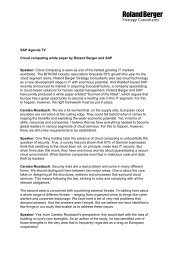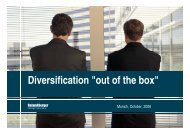"Automotive inSIGHTS 2/2010" (PDF, 3784 KB - Roland Berger
"Automotive inSIGHTS 2/2010" (PDF, 3784 KB - Roland Berger
"Automotive inSIGHTS 2/2010" (PDF, 3784 KB - Roland Berger
You also want an ePaper? Increase the reach of your titles
YUMPU automatically turns print PDFs into web optimized ePapers that Google loves.
MOBILITy CONCEpTS<br />
clearly sees itself as a mobility provider. Not only does<br />
it provide the vehicles, its services range from supplying<br />
electricity to offering extensive navigation services.<br />
Mobility services, and car-sharing initiatives in particular,<br />
are currently a trend mainly found in Western industrialized<br />
countries. Especially the German market is growing<br />
at a rate second only to the US. Already today, in Germany<br />
alone there are approx. 160,000 people involved in car-<br />
sharing initiatives and have access to roughly 4,700<br />
vehicles. Experts expect these numbers to rise to over<br />
one million people and almost 20,000 vehicles in<br />
Germany by 2016.<br />
If these concepts catch on, this could represent an additional<br />
threat to carmakers' sales. The break-even point for<br />
owning a vehicle is still today at approx. 10,000 km a year,<br />
according to the German federal association CarSharing 4) .<br />
A study carried out by AXA Group shows that already today,<br />
46% of the population drive less than this threshold and<br />
20% even drive less than 5,000 km 5) . Once customer get<br />
past the emotional ties of owning a vehicle and the status<br />
symbol it represents, car sharing may become a viable<br />
option, especially if they live in an urban area. A study<br />
by Frost & Sullivan predicts that mobility concepts could<br />
cause 1 million cars per annum to be sold less in Europe<br />
in the midterm.<br />
However, key questions involving mobility concepts<br />
have not yet been conclusively answered in the industry,<br />
such as:<br />
> How are mobility needs actually changing<br />
in the various markets and consumer groups?<br />
> What impact/risks do these have on/for traditional<br />
business models in the automotive industry?<br />
> What do possible alternative new business models<br />
look like and what new market players will emerge?<br />
> How should automotive manufacturers and service<br />
providers respond?<br />
> What role does electromobility play in the longterm?<br />
Daimler, Peugeot and BMW belong to the first automotive<br />
manufacturers to respond with comprehensive pilot<br />
projects. Besides the positive PR that goes along with<br />
such activities, they are motivated by the specific goal<br />
of generating profits in the medium term.<br />
1) Refer also to "<strong>Automotive</strong> 2025" in <strong>inSIGHTS</strong>, 1/2010.<br />
2) All car-sharing activities are consolidated under its new name "Flinkster – Mein Carsharing". This means that the more than 110,000 car-sharing<br />
Deutsche Bahn customers have 4,500 vehicles at their disposal throughout Europe at over 1,900 stations and in more than 580 cities.<br />
3) Sixt is trying to reach "young and price-conscious city dwellers" at over 45 locations in Berlin and Munich. As of January 2010, there were already<br />
approx. 1,600 users with access to 62 vehicles.<br />
4) Information from "Bundesverband CarSharing e.V." Other experts state 7,000 kilometers as the critical limit.<br />
5) AXA Traffic Safety Report 2009.<br />
11

















